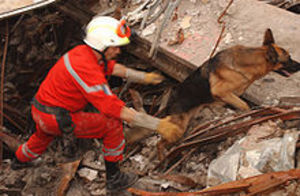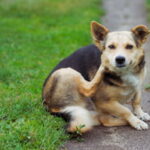The main goal of cadaver dog training is to teach the dog to give a signal such as barking when he or she recognizes the scent of a dead body part. Some dogs in the UK have refined this to such an art form that they can sniff out drops of burnt blood in burnt out cars. Not all dogs are cut out to be cadaver dogs and not all trainers are cut out to be cadaver dog handlers.
Qualities of a Cadaver Dog
Cadaver dogs are often dogs that were abandoned by former owners for having too much energy. Dog breeds that have become successful cadaver dogs include Labrador retrievers, English Springer spaniels, border collies, Rhodesian ridgebacks, bloodhounds and German shepherds. Mongrels and crossbreeds can also be trained as cadaver dogs, provided they have the right drive to follow a trail for a special reward.
Cadaver dogs need a motivation in order to bother following a trail and then signaling their human handlers. Their reward must be the best thing on the planet. The reward is only given when the dog signals. These rewards are often toys such as Frisbees, tennis balls or tug-type toys. The dogs must go through a long training process to learn that they will only get their coveted toy when they signal an actual find instead of just giving the signal whenever they feel like it.
The Scent
One slight problem of training cadaver dogs is a lack of cadavers to work with. Dogs have been trained with any mammalian meat or blood but cadaver dogs learn best with human DNA. Although police handlers can legally get a hold of body parts and store it in a freezer, the volunteer cadaver search dog handler cannot. Volunteers may be able to work out an arrangement with doctors or dentists to get a hold of material cut from patients. Even a rotting tooth can be used as a training aid. However, these have to be handled with extreme care as they will have bacteria on them that can get a person very sick.
In order to help train dogs (and help raiding the freezer a little safer) pseudo-scents were developed in the late 1980s. These scents chemically mimic that of a rotting human corpse.
There are problems with pseudo-scents. Cadaverdog.com notes that dogs trained to detect the real thing will ignore pseudo-scents. Dogs know the difference. Dogs trained on real body parts will have to be retrained with pseudo-scent of that is the only scent available.
Learning
Only a half a teaspoon or so of material needs to be placed in a plastic container. A number of identical plastic containers are placed inside of bricks or a wooden container with holes in it. The dog sniffs all of the holes. At first, the handler knows which hole is the correct one and rewards the dog as soon as that nose reaches the hole. The dog is taken away and the scent is moved to a different hole and the process is repeated.
Soon, the dog associates the smell of corpse with the appearance of his favorite toy. Over time, these sessions become longer and more complicated, with the scent being placed in far more bizarre situations, like warehouses or the wilderness.
References:
“Dog Heroes of September 11th.” Nona Kilgore Bauer. Kennel Club Books; 2006.
Dog Owner’s Guide. “Cadaver Dog.” http://www.canismajor.com/dog/cadog.html
Your Dog.com. “Detective Shep.” http://www.yourdog.co.uk/Dog-tales/Detective-Shep.html
Cadaverdog.com



